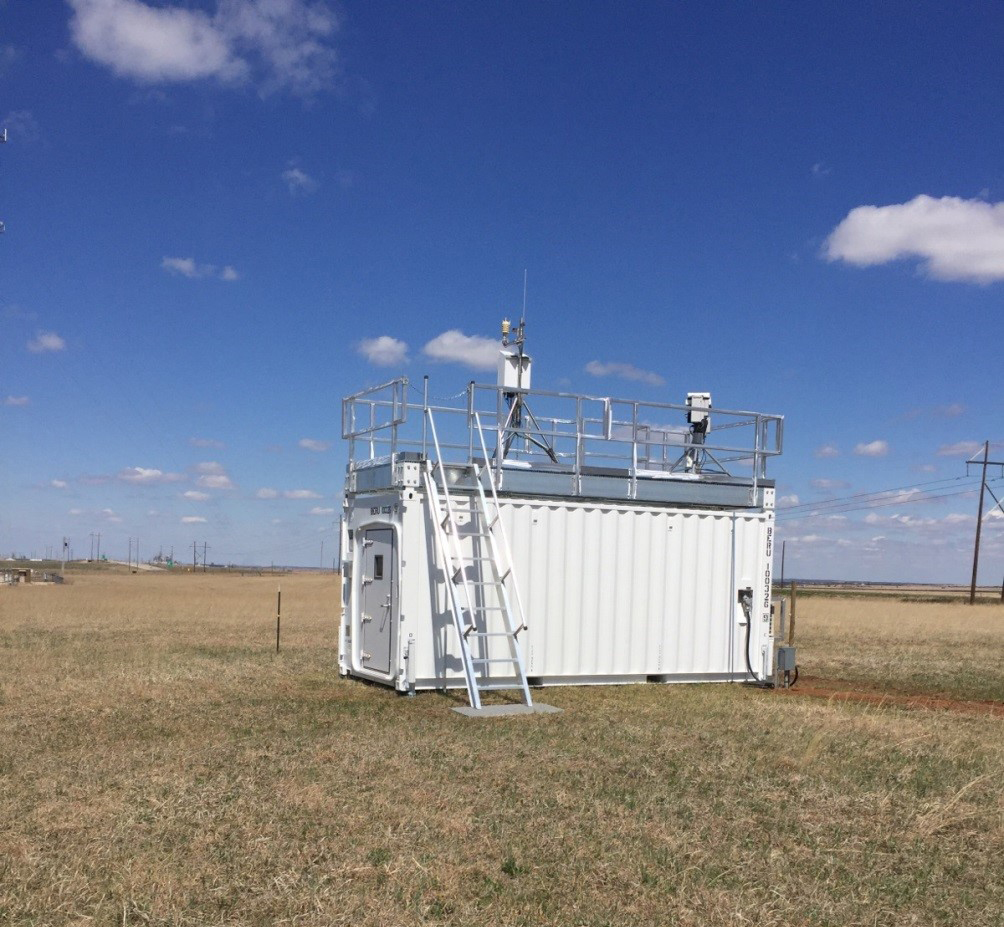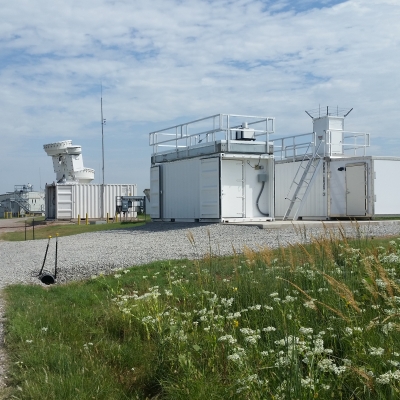ARM staff meet milestones in completing instrument upgrades

As part of the next-generation ARM Facility initiative set forth in the 2014 Decadal Vision, the Southern Great Plains (SGP) site in Oklahoma has been undergoing a reconfiguration to become a “megasite.”
New instrumentation began arriving on site for installation in spring and summer of 2015, some of it refurbished and redeployed from the former Tropical Western Pacific site. The added instrumentation includes four Doppler lidars, three Atmospheric Emitted Radiance Interferometers (AERIs), an Atmospheric Sounder Spectrometer for Infrared Spectral Technology (ASSIST), and four 3-channel microwave radiometers (MWR3C) repurposed to provide temperature, water vapor, and wind profiling, and other measurements associated with the data needed to inform and evaluate the Large-eddy Simulation (LES) ARM Symbiotic Simulation and Observation (LASSO) workflow.
“These changes are exciting because they make new measurements possible—data that improve our understanding of the atmosphere,” said Nicki Hickmon, SGP Facility Manager from Argonne National Laboratory.
User Friendly Changes
Responding to user requests to enhance the scientific measurements relevant to understanding land-atmosphere interactions and shallow convection at the SGP site, the ARM Facility undertook the reconfiguration to improve observations and data acquisition on temperature, humidity, and wind in the planetary boundary layer. The reconfiguration has focused on installing four new profiling modules:
- Soil Temperature and Moisture Profiles (STAMP) system, which replaces the former Soil Water and Temperature System (SWATS) that measured soil temperatures and estimated soil-water potential and volumetric water content.
- MWR3C, which measures liquid water path, narrowband brightness temperature, and precipitable water vapor.
- AERI or the ASSIST, which measure longwave spectral brightness temperature and longwave spectral radiance.
- new Doppler lidar, which provides vertical profiles of wind speed, direction, and vertical velocity.
Radar upgrades were considered, but the current setup will continue in use.
The creation of the SGP megasite is now essentially finished, except for the instrument module for a new Aerosol Observing System (AOS), which measures a host of attributes of atmospheric aerosols.
The SGP AOS’s instrument module is currently being completed and will be installed this winter. The site has been prepared and the enclosure installed, while the module is being instrumented at Brookhaven National Laboratory. Other than a slight delay due to the manufacturer’s delivery date slipping for this unit, everything has gone to plan and schedule.

Plug-and-Play Movable Modules
Mike Ritsche, Assistant SGP Facility Manager from Argonne National Laboratory, recently completed functional checks of the new AOS and is now doing the same for the new profiling modules. He says the four new profiling modules “allow us to meet our objectives for the LASSO large-eddy module, but they are also expandable in scope and relocatable, so they can be moved throughout the lower 48 states, as needed. This is a big change for SGP, where fixed installations have been the rule.”
Hickmon points out that while ARM’s mobile facilities are often in the news more, since they have new locations every year or two, the “SGP is important as a fixed megasite producing long-term data sets as a baseline” and supporting six or seven field research campaigns that are typically running there.
Twenty-five full-time staff, led by John Schatz, SGP’s local site manager, helped implement the reconfiguration. The on-site team includes electronic technicians, Linux and personal computer (PC) experts, facilities and administrative staff, and site monitors.
The SGP becoming a megasite will not change staff members’ regular work. “We’re essentially caretakers, with two main roles,” said Schatz. “We do scheduled preventive maintenance and ad hoc repairs to keep the instruments up and the data flowing, and we support guest researchers on visiting campaigns. Our goal is to meet their expectations so their visits are truly productive.”

Upgrades are Ongoing
While the reconfiguration wraps up, SGP staff are busy on several fronts. Testing is currently underway of a new mobile C-band Scanning ARM Precipitation Radar (CSAPR) that will be deployed to another site.
The Raman lidar at the SGP has been updated and moved closer to other instruments so their measurements can be combined. In use since the early 1990s, it is the oldest operating Raman lidar in the United States.
A new precipitation reference system is also being installed so that the ARM Facility can standardize how precipitation is recorded according to the type of local environment—say Great Plains of Oklahoma, boreal forest, or tropical rain forest.
Ritsche said that the SGP changes have been partly driven by a new precipitation measurement strategy. “It used to be that most precipitation data gathered were local measurements with rain gauges for climatology. Now we need to know what’s actually falling from clouds in more detail. Parsivel [laser] disdrometers let us do that where precipitation is in liquid form.”
These laser optical instruments, which were installed at SGP before the reconfiguration, observe drop size distribution in rain events and classify precipitation type. However, in the Arctic, for example, other instruments are required to observe precipitation falling as snow and ice.
Ritsche sums up the can-do attitude that motivates ARM’s SGP team: “Murphy’s Law is alive and well in the Southern Great Plains, just like anywhere else, but we’ve always managed to get the job done. Science depends on it.”
# # #
The ARM Climate Research Facility is a national scientific user facility funded through the U.S. Department of Energy’s Office of Science. The ARM Facility is operated by nine Department of Energy national laboratories including Argonne National Laboratory, which manages the ARM Southern Great Plains megasite.

